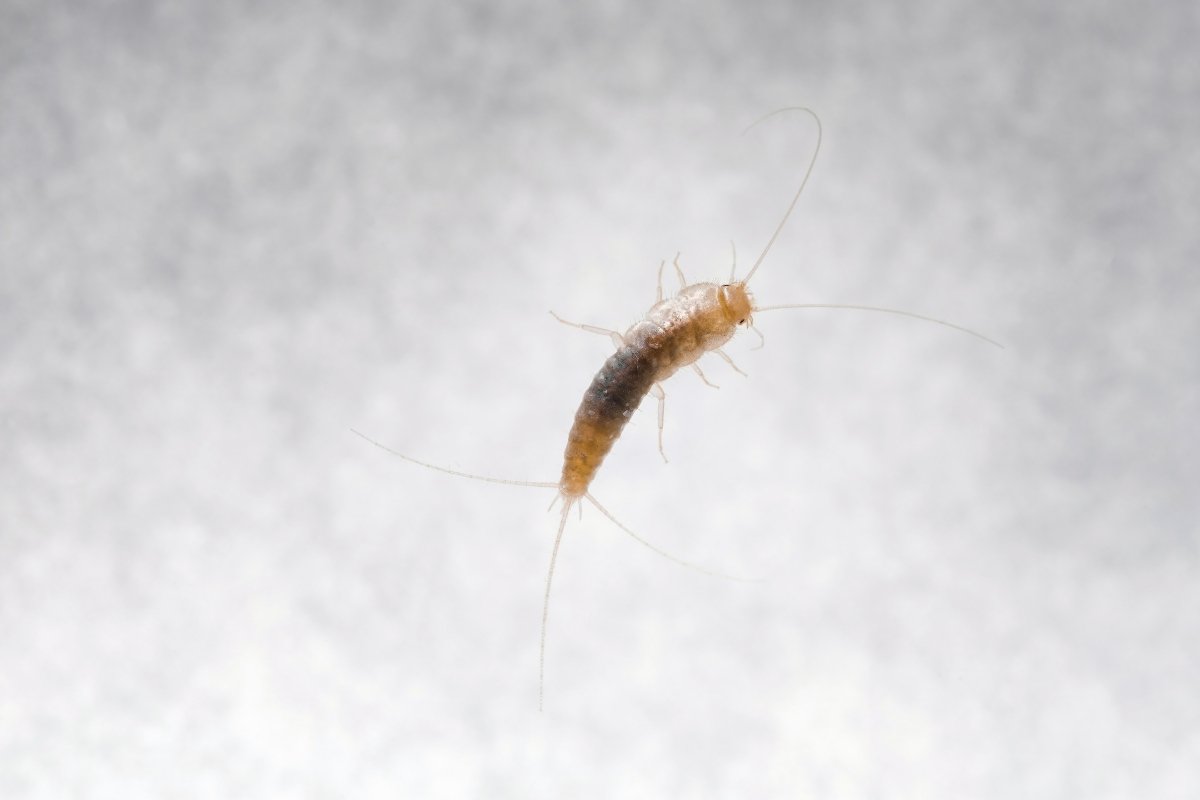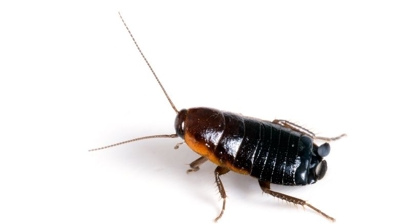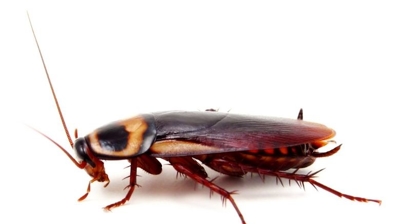
Firebrat Control Services

Firebrats
Firebrats (Thermobia domestica) are small, wingless bristletails that resemble silverfish, but they thrive in warmer, more humid environments, often near heat sources. While they are generally not considered as damaging as some other pests, they can still be harmful in several ways:
- Damage to Property and Belongings: Firebrats are known to feed on organic materials, including starches, sugars, and even some fabrics. This means they can cause damage to a variety of household items, such as books, wallpaper, clothing, and pantry items. Over time, their feeding can lead to noticeable damage or degradation of these materials.
- Contamination of Food: Although firebrats primarily feed on non-food materials, they are often found in areas where food is stored, like pantries or kitchens. Their presence could lead to contamination of food, as they may crawl across edible items, leaving behind feces, scales, or saliva. This could pose a risk to food safety and hygiene.
- Attracting Other Pests: Firebrats are sometimes found in conjunction with other pests, such as cockroaches and termites. Their presence in the home could indicate an environment that is conducive to other, more dangerous pests, making their detection a potential warning sign.
- Allergic Reactions: Though not a common issue, firebrats can sometimes trigger allergic reactions in sensitive individuals. The shedding of their scales or feces may contribute to dust and allergens in the environment, particularly in areas where firebrats are abundant.
- Presence as a Sign of Poor Sanitation: A firebrat infestation can indicate problems with moisture and poor sanitation in the home. Their preference for warm, humid environments, such as basements, attics, or areas near heating ducts, may suggest moisture issues that could also promote the growth of mold or mildew. This can contribute to a decline in air quality and potentially cause structural problems over time if the moisture issue isn't addressed.
While firebrats do not usually pose a direct health threat, their presence can be a nuisance and may indicate underlying issues with your home’s condition, which could lead to more serious concerns if left unchecked.
Learn more: Do Firebrats Bite?
Firebrat Removal
Firebrats may seem harmless at first glance because they do not bite or transmit diseases to humans. However, eliminating them is important for several reasons:
- Damage to Property: Firebrats feed on starchy materials, carbohydrates, and proteins. This includes book bindings, wallpaper paste, cardboard, fabrics, paper, and even certain insulation materials. In severe infestations, they can cause structural damage to books, stored documents, clothing, and packaging materials, which can be costly to repair or replace.
- Contamination of Stored Goods: While they do not carry pathogens in the way some insects do, firebrats leave behind feces, shed skins, and other debris. This contamination can render food, packaging, or stored materials unsanitary, especially in commercial settings like warehouses or food storage areas.
- Allergen Production: Their droppings, shed exoskeletons, and body parts can act as allergens, potentially triggering respiratory irritation, asthma, or allergic reactions in sensitive individuals.
- Indicators of Environmental Problems: Their presence often signals a warm, humid, and poorly ventilated area, or moisture problems in buildings. Ignoring them can allow these underlying conditions to persist, potentially leading to mold, structural decay, or other pest infestations.
- Difficult to Control Once Established: Firebrats are nocturnal, fast-moving, and thrive in cracks, crevices, and hidden spaces, making them difficult to detect and control. Early intervention is crucial to prevent a persistent infestation that may require more intensive pest management measures.
- Rapid Reproduction: Firebrats reproduce quickly, especially in warm, humid environments. A small infestation can escalate rapidly, making eradication more difficult if action is delayed.
Firebrats are more than a minor nuisance—they can compromise stored items, contaminate environments, contribute to allergens, and multiply quickly under ideal conditions. Prompt identification and elimination are essential to protect both property and health.
Learn more: How To Get Rid Of Firebrats
Firebrat Control
Hiring our professional pest control for firebrats is highly recommended because these pests can be persistent, destructive, and very difficult to manage without our expert intervention. Here are some of the reasons why our professional treatment is the best choice:
- Accurate Identification: Firebrats are often mistaken for other small insects. Our trained pest professionals can correctly identify the species, ensuring that the treatment plan directly targets the problem instead of wasting time and money on ineffective DIY methods.
- Hidden Infestations: Firebrats prefer warm, dark, and secluded environments such as attics, basements, boiler rooms, or near hot water pipes. They are nocturnal and rarely seen during the day, making infestations hard to detect. Our professionals know where to look and how to locate hidden populations.
- Property Protection: While firebrats don’t bite or spread disease, they are destructive to property. They feed on starchy materials, books, wallpaper paste, fabrics, insulation, and even certain stored foods. Left unchecked, they can cause costly damage to household items and building materials.
- Targeted Treatment Plans: DIY sprays and traps may kill a few firebrats but won’t address the root of the problem. Our professionals use proven methods, such as residual treatments, baiting, and environmental modifications, to eliminate both visible insects and hidden colonies.
- Long-Term Prevention: Firebrats thrive in warm, humid spaces, which makes reinfestation likely if conditions remain favorable. Our pest control experts not only remove the current infestation but also advise on prevention strategies—such as sealing cracks, improving ventilation, and reducing food sources—to keep them from returning.
- Cost & Time Efficiency: Trying to handle an infestation yourself can lead to repeated expenses on ineffective products and wasted time. Our professional pest control provides a comprehensive solution that resolves the issue faster, protects your property, and saves you money in the long run.
Hiring our professional pest control for firebrats gives you peace of mind, prevents property damage, and ensures lasting results.
Firebrat Exterminators
Hiring our local exterminators for firebrats instead of a national company offers distinct advantages that are particularly relevant for this pest. Firebrats thrive in specific microenvironments—warm, humid, hidden spaces—and eradicating them requires nuanced, targeted strategies rather than generic treatments. Here’s why our local professionals are the better choice:
- Deep Knowledge of Local Conditions: Our local exterminators understand the climate, typical building structures, and humidity patterns in your area. Firebrats proliferate in warm, moist environments, often around water heaters, boilers, attics, or insulation. Our local experts quickly identify the most likely hotspots based on regional conditions, which a national company relying on standardized protocols might overlook.
- Experience with Firebrats Specifically: National companies often focus on common pests like ants, roaches, or rodents. Firebrats are a niche pest requiring careful inspection and specialized techniques, such as habitat modification, humidity control, and precise placement of baits or insecticides. Our local exterminators are likely to have more hands-on experience dealing with firebrat behavior and lifecycle.
- Faster Response and Follow-Up: Our local professionals can respond quickly to your site, conduct thorough inspections, and perform follow-ups without the logistical delays that large corporate chains may face. Firebrats reproduce rapidly, so timely intervention is critical to prevent a small infestation from exploding into a persistent problem.
- Customized, Integrated Solutions: Our local exterminators provide a more tailored Integrated Pest Management (IPM) plan, combining habitat modification, sanitation, moisture control, and targeted chemical treatments. National companies often use pre-packaged service plans that may not address the subtle environmental adjustments firebrats need to be fully eliminated.
- Long-Term Prevention Advice: Eliminating firebrats is only part of the process; preventing their return is equally important. Our local exterminators advise on practical, site-specific measures—such as ventilation improvements, insulation adjustments, leak repair, or humidity reduction—that align with your building and climate. National companies may give generic advice that isn’t as relevant in your particular setting.
Firebrat infestations are subtle and site-specific. Our local exterminators' knowledge of regional environmental conditions, building structures, and firebrat behavior gives us a tactical advantage that large, nationwide companies often cannot match. We combine precise eradication with practical prevention measures, ensuring the infestation is not only controlled but unlikely to return.
What Do Firebrats Look Like?
Firebrats, scientifically known as Thermobia domestica, are close relatives of and look similar to silverfish, but have distinct physical characteristics that set them apart from silverfish and other insects. Here is a detailed description of their appearance:
- Size: Firebrats are relatively small insects, typically measuring between 6 to 12 millimeters (0.24 to 0.47 inches) in length.
- Body Shape: They have an elongated and flattened body, which gives them a somewhat carrot-shaped appearance.
- Color: The body of a firebrat is covered in small, silvery scales, which give it a shiny, metallic appearance. However, the scales can also appear mottled with dark patches, depending on the individual and its age.
- Antennae: Firebrats have long, slender antennae that are nearly as long as their body. These antennae are one of their distinguishing features and are used for sensory perception.
- Eyes: They have small, compound eyes on the sides of their head, which are not very prominent due to their nocturnal nature.
- Legs: Firebrats have six legs, which are relatively short and sturdy, aiding in their quick movements.
- Wings: One of the most notable characteristics of firebrats is that they are wingless. Unlike some other insects in the order Zygentoma, firebrats do not possess wings. This lack of wings distinguishes them from winged insects.
Firebrats are small, elongated insects with a flattened body covered in silvery scales. Their long antennae and wingless appearance make them easily recognizable. These physical adaptations are well-suited for their habitat and lifestyle, which typically involves living in warm, dry indoor environments.
Where Are Firebrats Found?
Firebrats (Thermobia domestica) are commonly found in indoor environments, particularly in places where they can thrive in warm and dry conditions. Here is a detailed description of the typical locations where firebrats are commonly found:
- Homes: Firebrats are often encountered in homes, especially in areas with elevated temperatures. They may be found in kitchens, near ovens, stoves, or hot water heaters, as these appliances generate warmth. They are also known to inhabit wall voids, behind baseboards, and in crawl spaces.
- Commercial Buildings: Firebrats can infest commercial structures such as restaurants, bakeries, and food storage facilities due to the availability of starchy materials like flour and food crumbs.
- Warehouses: In warehouses and storage facilities, firebrats can be found among stored goods and cardboard boxes, as they feed on paper products and cardboard.
- Libraries and Museums: These insects can be a nuisance in libraries and museums, where they may damage books, paper documents, and artifacts. They are attracted to the cellulose and glue found in these materials.
- Bathrooms: Firebrats may inhabit bathrooms, especially if there are warm pipes or heating ducts nearby. They can be found in hidden cracks and crevices.
- Basements: In homes with warm and humid basements, firebrats may take up residence in dark corners and crevices.
- Boiler Rooms: The warm and dry conditions of boiler rooms make them attractive to firebrats. They may be found near heating systems or pipes.
- Greenhouses: In some cases, firebrats can infest greenhouses, as the warm and humid environment can provide suitable conditions.
- Restaurants and Bakeries: Commercial kitchens and food preparation areas provide an abundance of food crumbs and starchy materials, making them attractive to firebrats.
- Libraries and Archives: Firebrats are known to damage books, manuscripts, and historical documents in libraries and archives. They can be found in bookshelves and storage areas.
Firebrats thrive in environments with temperatures ranging from 90°F (32°C) to 110°F (43°C) and prefer dry conditions. They are nocturnal, which means they are most active during the night when the environment is cooler. Effective pest control measures may be necessary if firebrats become a nuisance in these locations, especially when they start causing damage to stored items or structural materials.
What Do Firebrats Eat?
Firebrats (Thermobia domestica) are opportunistic feeders and consume a variety of organic materials. They are particularly attracted to substances rich in carbohydrates. Here is a more detailed description of what firebrats eat:
- Starchy Materials: Firebrats have a strong preference for starchy materials. They feed on items such as paper, cardboard, and book bindings, as these materials contain cellulose and other carbohydrates. In homes and libraries, they are known to damage books, paper documents, wallpaper, and cardboard boxes.
- Glue: Firebrats are drawn to glue, especially the types used in bookbinding and wallpaper adhesive. They may nibble on the glue found in books or the glue used to attach wallpaper to walls.
- Food Crumbs: In kitchens and areas where food is prepared or stored, firebrats can feed on food crumbs and particles. They are attracted to spilled grains, cereal, flour, and other pantry items.
- Fabric: Although not their primary source of nutrition, firebrats may occasionally feed on fabrics, particularly those stained with food or other organic substances. They are not as destructive to fabrics as some other pests.
- Dead Insects: Firebrats are scavengers and may consume dead insects that they come across in their environment.
- Mold and Fungus: In humid conditions, firebrats may also feed on mold and fungus growing on surfaces, as these can be sources of moisture and nutrients.
- Pet Food: If pet food is left exposed in areas where firebrats are present, they may nibble on it, as it contains carbohydrates.
- Hair and Dandruff: In some cases, firebrats have been observed feeding on human hair and dandruff, although this is not a common food source for them.
Firebrats are primarily active at night, and their feeding habits are influenced by their nocturnal behavior. They are more likely to forage for food in the dark when the environment is cooler and less populated. Effective pest control measures, such as eliminating food sources and maintaining a clean and dry environment, can help prevent infestations of firebrats, especially in areas where they can cause damage to valuable items.
Firebrat Life Cycle
The life cycle of a firebrat (Thermobia domestica) consists of several stages, from egg to nymph to adult. These insects undergo gradual metamorphosis, which means that the nymphs resemble miniature adults but lack wings and reproductive organs. Here's a more detailed overview of the firebrat life cycle:
- Egg Stage: The life cycle begins when adult female firebrats lay eggs in concealed and sheltered locations, such as cracks, crevices, and hidden areas of their habitat. The eggs are small, oval-shaped, and typically white or pale yellow. The exact number of eggs laid by a female can vary but often ranges from a few dozen to several hundred. The duration of the egg stage depends on environmental conditions, primarily temperature and humidity. It can last anywhere from a few weeks to a few months.
- Nymph Stage: Once the eggs hatch, they give rise to nymphs. Firebrat nymphs closely resemble miniature versions of adult firebrats but are smaller and lack wings. Nymphs go through a series of molts as they grow. Each molt results in a slightly larger nymph with more developed features. The number of molts varies among individuals, but it typically ranges from 7 to 13 molts before reaching adulthood. The exact number of molts can be influenced by factors such as temperature and food availability. During the nymph stage, firebrats are active, feeding on a variety of organic materials, particularly carbohydrates like paper and glue. They are primarily nocturnal, and their activity is highest during the night.
- Adult Stage: After the final molt, the firebrat reaches adulthood. Adult firebrats have a more elongated and tapered appearance compared to nymphs. Unlike nymphs, adult firebrats have well-developed reproductive organs, but they remain wingless throughout their entire life. Firebrats are capable of mating shortly after becoming adults. They reproduce by laying eggs, and the cycle continues.
- Reproduction: Adult female firebrats can lay eggs throughout their lifespan, with the number of eggs laid varying depending on factors like temperature and food availability. Mating typically occurs when a male locates a receptive female, and they engage in a courtship ritual before mating. After mating, females seek out suitable egg-laying sites to deposit their eggs, often in hidden and protected areas.
The entire life cycle of a firebrat, from egg to adult, can take several months to a few years, with environmental conditions playing a significant role in the duration of each stage. Firebrats are known for their ability to adapt to warm and dry environments, which allows them to thrive in indoor locations where they can find suitable food sources and shelter.

Hear From Our Happy Customers
-
"Wonderful Service"
Wonderful service. Jarvis is great. Took care of everything I needed. Thank you!
- Henry P. -
"Very Knowledgeable"
The tech that arrived was courteous, professional, and very knowledgeable. He was Great.
- Uerial I. -
"Professional & Considerate"
I’m pleased with Miche services. Jarvis came today. Professional and considerate. Thank you!
- Judy B. -
"Great Communication"
Tech was on time, communication was great, and he accommodated my needs.
- Alonzo W. -
"Fantastic & Patient"
Jarvis was fantastic and patient. He answered my questions with an in-depth explanation and addressed all of my areas of concern. Would love for him to be my assigned tech going forward. Well done!
- Yonnette M. -
"Exceeds Expectations"
I can’t say enough positive things about this company... The tech that came out, Jarvis went above and beyond my expectations. Thank you guys, I will continue using your services.
- Jake M.



